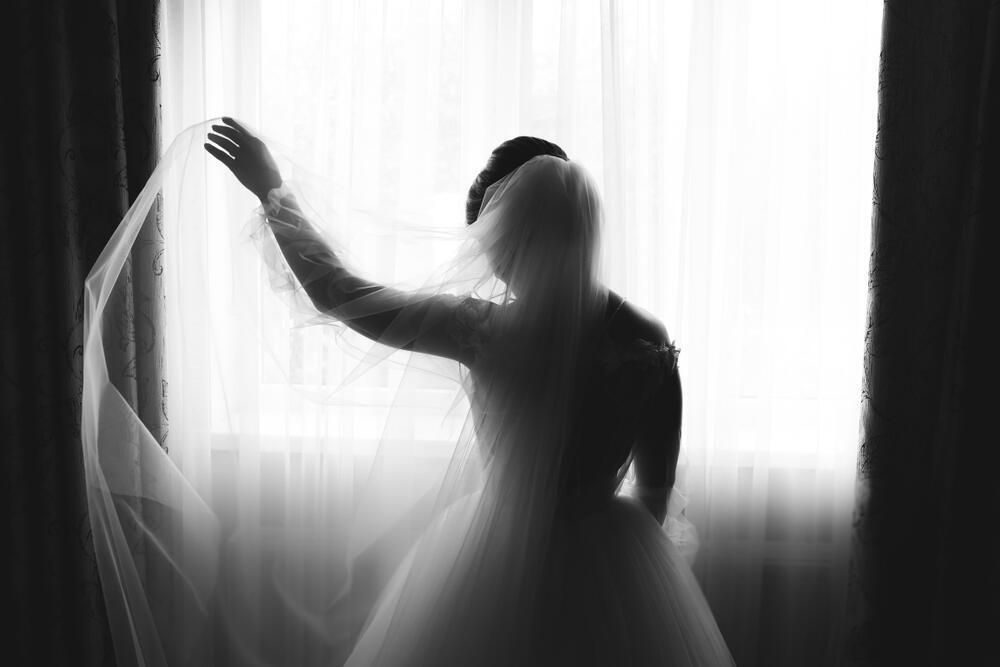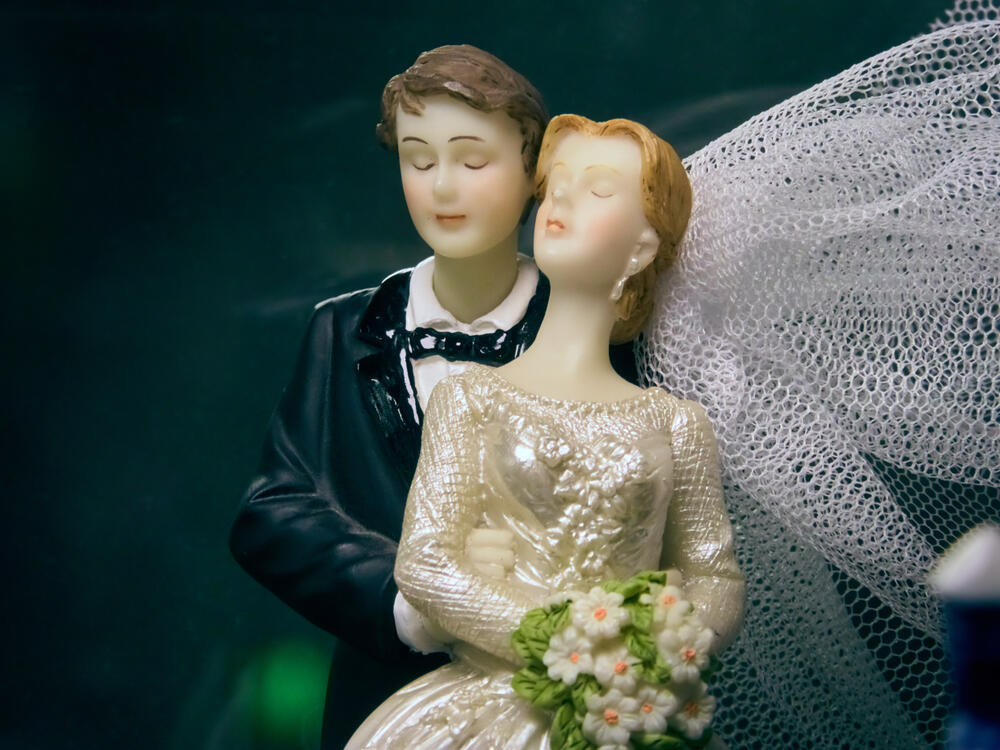Years ago, ahead of her wedding, curator and scholar Dr. Nurit Sirkis Bank debated the matter with her mother, Ruth Sirkis, a pioneering Israeli cookbook author.
“I wanted to wear a completely opaque veil, but my dear mother preferred a transparent one,” recalls Sirkis Bank, who became religious in her youth and now lives in an ultra-Orthodox community. “She told me she would sew me a transparent veil herself, and she did; she made me a beautiful one, which I keep to this day.”
9 View gallery
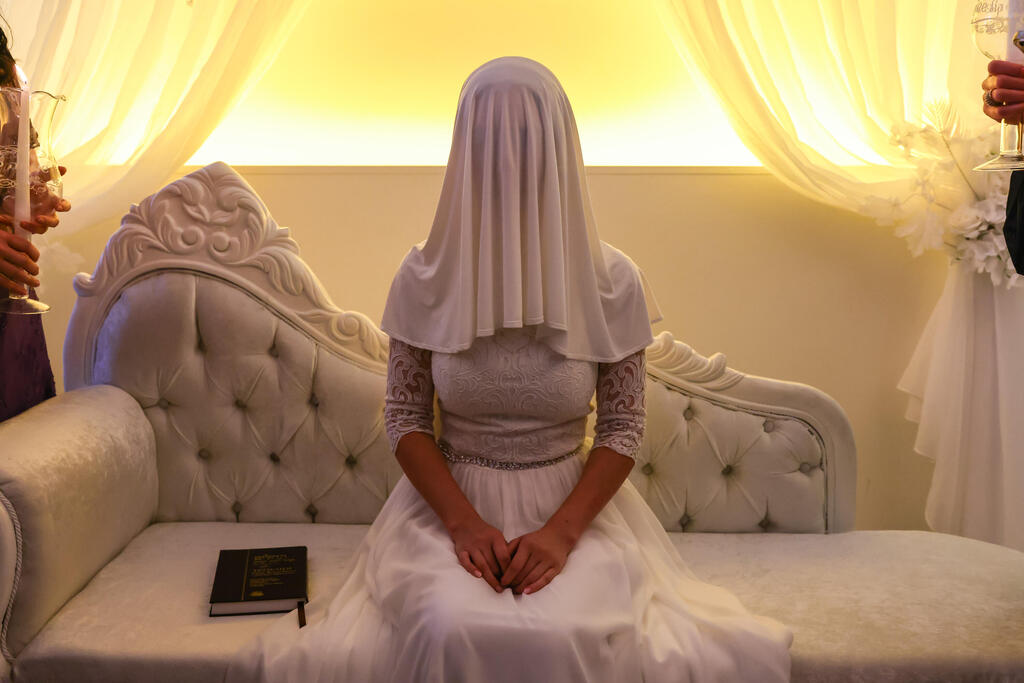

A bride with an opaque veil, customary in Hasidic circles
(Photo: Omer Messinger / Getty Images)
“The fact that my veil was transparent made me aware that everyone could see me, and that the photographer could capture me,” Sirkis Bank recalls. “I felt like I had to smile, that I couldn’t close my eyes and cry from emotion or take a minute to myself, because it was clear that I was, somewhat, a visual object. When my daughter got married, we searched and found a special fabric so that no one could see her face from the outside, but she could still see what was happening.”
What fabric is the transparent veil made of?
Transparent veils are often made of tulle, a fabric woven with wide gaps between threads. “Every fabric is made of threads. The denser and tighter they are, the more opaque the fabric becomes,” she says. “Tulle is see-through, though there are other fabrics where the base thread itself is transparent, like fishing line. Tulle is common in the fashion industry and is used in many skirt undersides. A ballerina’s tutu, for example, is made of layers of tulle.”
For her doctorate at Bar-Ilan University, Sirkis Bank researched “Visual Aspects of Contemporary Hasidic Weddings” in Israel, during which she encountered many veils.
“A wedding is essentially a rite of passage, an irreversible one, which is found in all cultures”, she explains. “Both bride and groom wear clothing different from what they usually wear, marking a separation from their previous identity. They are the protagonists of the ritual and need to internalize that they are in a moment of transition, which is not a game but a really significant occasion.”
9 View gallery


Kate Middleton at her wedding in 2011. The veil is common in various cultures, including the Christian one
(Photo: Dan Kitwood / Getty Images)
She notes that in Hasidic circles, veils sometimes incorporate fabric from the head coverings or wedding dresses of prominent women from earlier generations, such as the rebbe’s wife.
“I attended a wedding where they said the veil contained a piece of fabric from the wife of the Seer of Lublin, Rabbi Yaakov Yitzchak Horowitz, who lived about 200 years ago. Having a piece of such an old fabric is incredible. You could tell it was old fabric, not something bought yesterday in Jerusalem’s Geula neighborhood,” she shares.
“A garment is passed down to someone belonging to the family’s ancestry, but the idea of passing down garments isn’t limited to the veil. Grooms may also wear items from previous generations, such as a shirt, kippah, or the ritual belt known as a ‘Gartel’. By doing so, the couple conveys a sense of holiness, inspiration, and the hope of living up to the spiritual level of their ancestors.”
The bridal veil is mentioned in the Mishnah, the earliest compilation of Jewish law, where it is referred to as a “hinuma.” Tractate Ketubot describes the hinuma, as well as the uncovered hair, as markers of a virgin bride:
“If a woman was widowed or divorced and says, ‘I was married as a virgin,’ while her husband says, ‘No, you were married as a widow,’ if there are witnesses that she went out with a hinuma and uncovered hair, her ketubah (marriage contract) is worth 200.”
9 View gallery
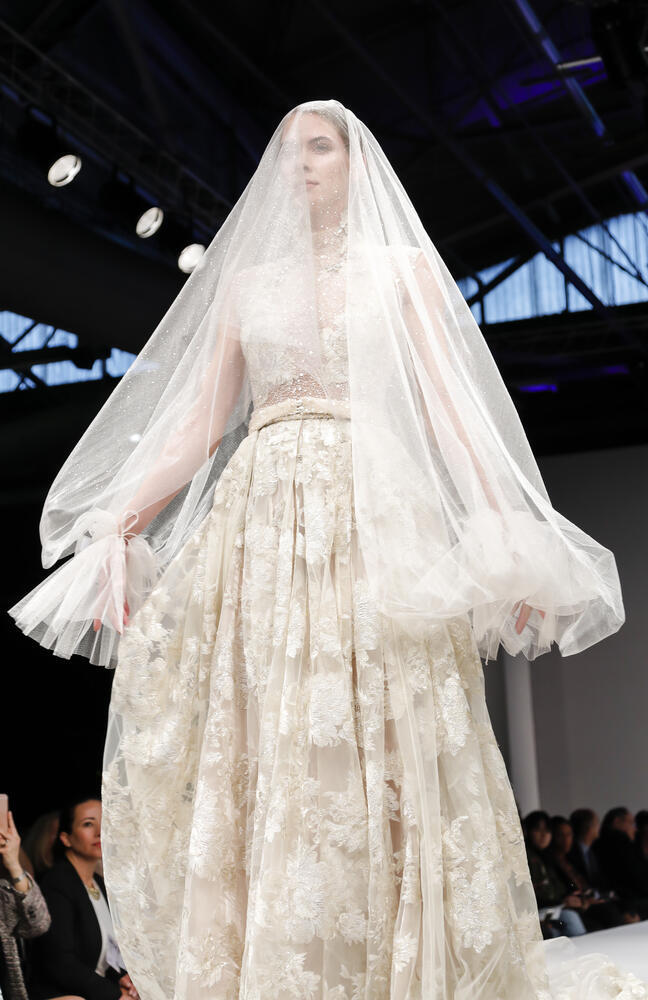

A model wears a wedding dress and veil designed by Simijan Buzaglo, at a fashion show in New York
(Photo: Sam Aronov / Shutterstock)
But what exactly was the “hinuma” as mentioned in the Mishnah? Rabbinic sages disagreed. One opinion linked it to a myrtle wreath. Medieval commentator Rashi (Rabbi Shlomo Yitzhaki) explained it as a cloth draped over the bride’s head and eyes, sometimes causing the bride to doze, hence the name “hinuma,” from the word for slumber.
Not everyone, however, sees the veil in a positive light. Notes Rabbanit Sarah Segal-Katz, a scholar and educator. “Some women say the veil creates an unpleasant sense of masking, distancing them from the event – from family, friends and the wider crowd – while also objectifying them. Others want precisely that sense of separation, so they can feel more inward during such emotional moments.”
In Jewish law, bringing the bride to the chuppah is considered an integral part of the wedding ritual. Today, “chuppah” refers to the canopy held up by four poles, under which the marriage ceremony takes place.
But in rabbinic literature, there were some interpretations of the “chuppah.” Some opinions held that the veil itself was the chuppah. To cover all interpretations, the custom arose that the groom covers the bride’s face with the veil before the ceremony begins.
Once associated mainly with Ashkenazi Jews, the bridal veil has, over time, spread to nearly all Jewish communities.
Rabbi Moshe Isserles, a 16th-century authority on Jewish law, wrote that modest brides customarily cover their faces and do not concern themselves with the value of the ring or object their groom uses for the wedding.
He points to two traditional reasons for the veil: modesty and a desire that the bride trust the groom without scrutinizing the value of the betrothal item, knowing it is worth more than one “prutah.”
Not everyone, however, sees the veil in a positive light. “Some women say the veil creates an unpleasant sense of masking, distancing them from the event – from family, friends, and the wider audience – while also objectifying them”, notes Rabbanit Sarah Segal-Katz, a scholar and a Halachic educator, founder of Gluya Magazine and a member of Beit Hillel rabbinic organization.
“Still, in most religious and secular weddings, the veil is lifted after the wine is sipped under the canopy and does not remain throughout the ceremony. In the ultra-Orthodox world, however, the veil often stays in place the entire time. Some brides even prefer the covering, so they can feel more inward during such an emotional moment.”
What do you think about completely opaque veils, through which the bride cannot see at all?
“Those who practice it can point to tradition in their defense,” Segal-Katz says. “Historically, it seems that transparent veils are the newer development. A critical feminist perspective might wonder how this can be done to a woman, as though erasing her.
On the other hand, in a strictly ultra-Orthodox wedding – where the ceremony is conducted by a man, blessings are recited by men, the audience is mostly men, and the women stand farther away behind a partition except for the mothers, who are present at the chuppah – an opaque veil can actually provide the bride with privacy, without feeling she is an object. Unlike other brides, she can cry, pray, laugh without being seen.”
What about divorced and widowed brides?
Because the veil is traditionally linked to virginity and first marriages, it is usually not used for second weddings when the bride is divorced or widowed.
“Yet I’ve accompanied couples in second marriages who wanted the veil as a way to say, ‘We also have a sense of firstness, regardless of what we’ve gone through,’” Segal-Katz explains. “For some women, it symbolizes the beginning of a new partnership, even if that symbolism is less common today.”
Segal-Katz also reminds readers that what many see as an essential stage of the wedding – the moment the groom approaches the bride’s chair and covers her with the veil – is actually an Ashkenazi Hasidic custom known as badeken, meaning “to cover.”
“The tension at that moment is heightened by another Hasidic practice: the couple often avoids meeting during the week before the wedding. The unveiling is then their first meeting in days, and the emotion for the couple and all the attendees is at its peak.”
Resistance to the veil is most common among women in more liberal, mixed-gender environments who wish to be active participants in their wedding.
“Religious women with feminist awareness often come with a background in Jewish learning, where their commitment to halacha (Jewish law) is combined with a desire for partnership and equality,” Segal-Katz says. “The same is true of some young grooms who grew up in religious communities where their yeshiva education fostered both serious Torah study and feminist consciousness, and where their relationship developed around those values.”
For Segal-Katz, the real debate is not only about the veil, but about the role of women in the ceremony itself.
“The central questions are how brides can be active participants in their own wedding rather than passive observers, and how other women can be included alongside the men,” she says. “Questions about the veil, circling the groom seven times, or breaking the glass to remember the Temple’s destruction are all questions of custom. A custom is not trivial; it cannot simply be dismissed, but in halachic-legal terms, the weight of chuppah customs is different from the actual act of betrothal, which is the core of the marriage.”
She adds that for many brides, the white gown and accompanying makeup, jewelry and hairstyle express a princess-like ideal, with the veil blending naturally into that image since it is also common in other cultures and religions.
“I personally wanted to keep the veil on during the entire chuppah ceremony to focus on the spiritual union of our souls,” she says. “But because we follow Sephardic practice and did not have the Ashkenazi custom of yichud (a private room for the couple after the chuppah ceremony), there was no discussion about keeping it throughout the wedding.”
9 View gallery
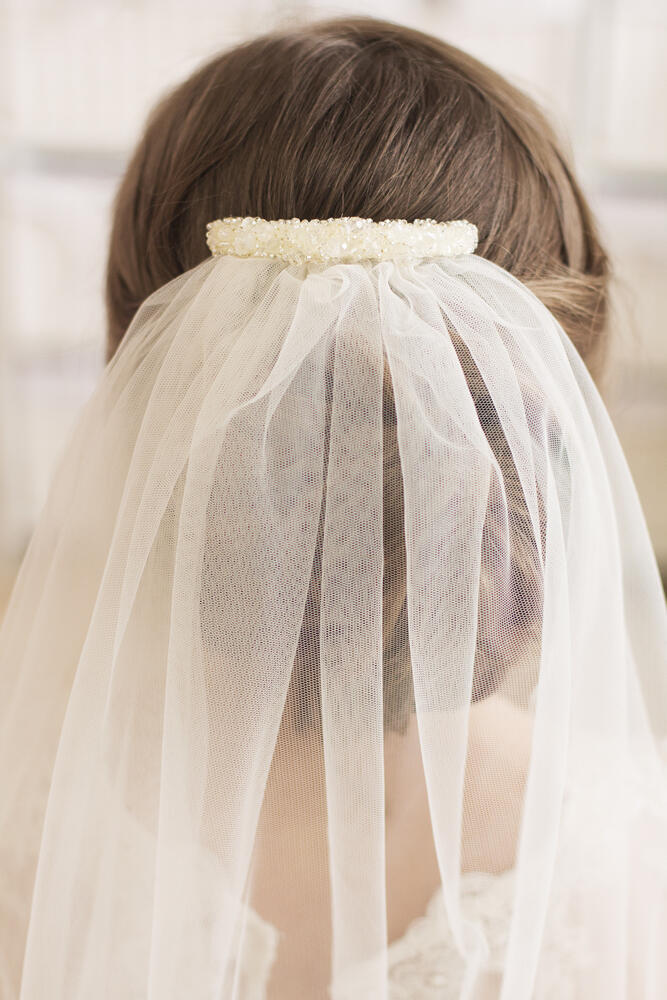

A veil – A symbol of virginity, modesty, or holiness
(Photo: Alexander Dyachenko / Shutterstock)
Rabbanit Dr. Michal Tikochinsky, a member of the Tzohar rabbinical organization, recalls that in her youth, the veil remained on the bride’s head until the end of the wedding; not covering the face, but flowing behind her. “Rabbis insisted on it, seeing it as a form of head covering,” she says. “In recent years, this practice has faded. Today, most brides remove the veil after the chuppah ceremony. There’s a certain rebellion against it.”
The question of whether the veil is about modesty or part of the marriage ritual remains unresolved. “We don’t know for certain what a chuppah originally was,” Tikochinsky says. “One opinion is that the veil itself is the chuppah. Today, all options are practiced, with the groom covering the bride with the veil before the ceremony.
“It’s a beautiful custom with deep symbolism”, adds Tickochinsky. “We already see with our matriarch Rebecca that when she saw Isaac, ‘she took her veil and covered herself’.” To me, this shows reciprocity between the bride and groom. I would never give it up lightly.”
9 View gallery
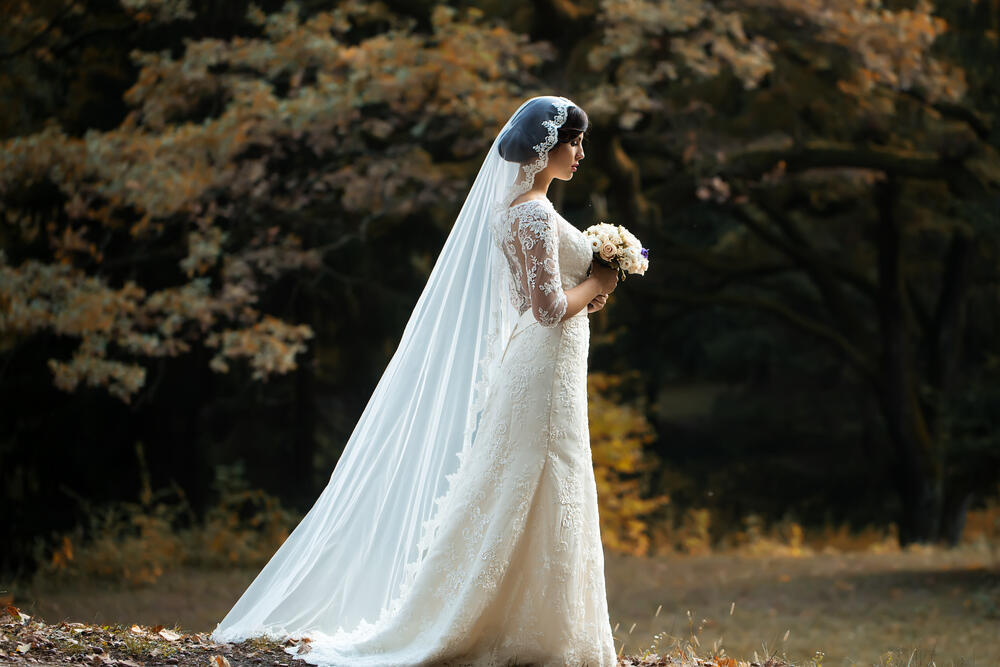

A bride with a long veil that reaches the floor.”It’s a beautiful custom”
(Photo: Volodymyr Tverdokhlib / Shutterstock)
“I don’t like giving up on traditions. When I got married, it never even crossed my mind to forgo the veil. It wasn’t something that weighed on me or bothered me,” she says. “I would suggest delving into the custom and understanding its roots. Often, it’s a matter of connection and deeper familiarity with the custom.”
Jewish mysticism infused the veil with additional significance. “In kabbalistic texts, the bride is called a ‘Merkava (chariot) for the holy Shechina'”, explains Dr. Nurit Sirkis Bank. “She is not the Shechina itself, which is something that is not tangible nor can be seen, but a Markava, the chariot that holds it.
“The sages also taught that ‘Blessing is found only in a matter concealed from the eye’.
Exodus Chapter 34 reads that ‘when Moses came down from Mount Sinai with the two tablets of the testimony in his hands, Moses knew not that the skin of his face sent forth beams while He talked with him’. The people of Israel could not see him nor approach him. He looked too sublime to them.
The veil reflects this idea. At her highest moment, when the bride becomes a wife, her face is said to radiate light. The covering shields her both from herself – allowing her to turn inward – and from those looking at her.”
The emotional tension of the moment is amplified in ultra-Orthodox weddings, where the bride and groom have not seen each other for at least a week. “The bride sits in her gown, waiting for him. The groom sees her face, confirms her identity, and then covers it with the veil,” Sirkis Bank says.
9 View gallery
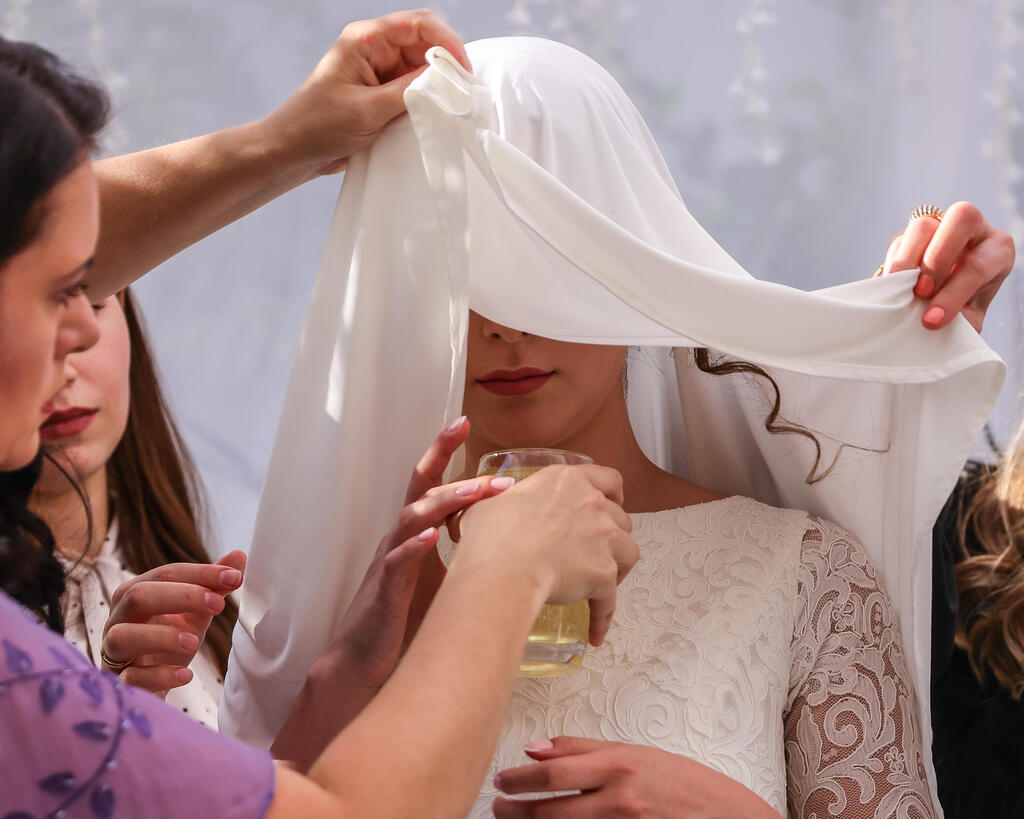

A bride covered in a veil drinks wine at the chuppah
(Photo: Omer Messinger / Getty Images)
Does he confirm her identity to prevent a mix-up behind the veil, like Jacob with Leah and Rachel?
“Exactly,” she replies. “He must see her first, confirm it is really her, and then cover her. By agreeing to let him veil her, the bride gives her first consent to the marriage. She can still withdraw consent at any stage, even when receiving the ring.”
She concludes with advice for brides: “The veil holds much depth, hidden meaning and mystery. I encourage every woman preparing for marriage to explore the custom for herself, just as she should explore other Jewish wedding traditions, and to connect with them in a way that feels personally meaningful.”





